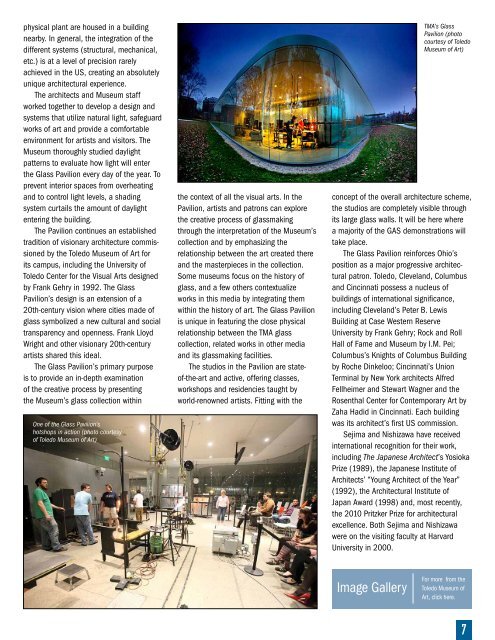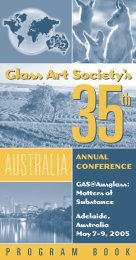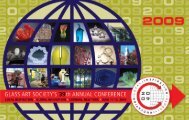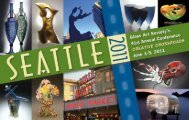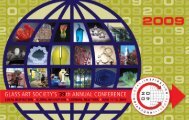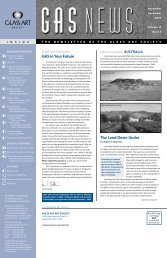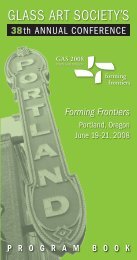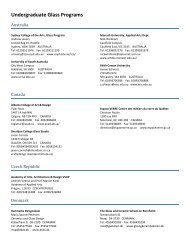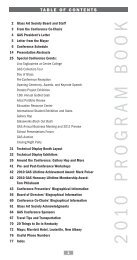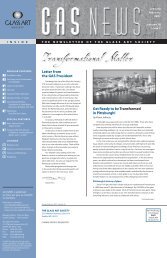GASNews October/ November 2011 Volume 22 ... - Glass Art Society
GASNews October/ November 2011 Volume 22 ... - Glass Art Society
GASNews October/ November 2011 Volume 22 ... - Glass Art Society
Create successful ePaper yourself
Turn your PDF publications into a flip-book with our unique Google optimized e-Paper software.
physical plant are housed in a building<br />
nearby. In general, the integration of the<br />
different systems (structural, mechanical,<br />
etc.) is at a level of precision rarely<br />
achieved in the US, creating an absolutely<br />
unique architectural experience.<br />
The architects and Museum staff<br />
worked together to develop a design and<br />
systems that utilize natural light, safeguard<br />
works of art and provide a comfortable<br />
environment for artists and visitors. The<br />
Museum thoroughly studied daylight<br />
patterns to evaluate how light will enter<br />
the <strong>Glass</strong> Pavilion every day of the year. To<br />
prevent interior spaces from overheating<br />
and to control light levels, a shading<br />
system curtails the amount of daylight<br />
entering the building.<br />
The Pavilion continues an established<br />
tradition of visionary architecture commissioned<br />
by the Toledo Museum of <strong>Art</strong> for<br />
its campus, including the University of<br />
Toledo Center for the Visual <strong>Art</strong>s designed<br />
by Frank Gehry in 1992. The <strong>Glass</strong><br />
Pavilion’s design is an extension of a<br />
20th-century vision where cities made of<br />
glass symbolized a new cultural and social<br />
transparency and openness. Frank Lloyd<br />
Wright and other visionary 20th-century<br />
artists shared this ideal.<br />
The <strong>Glass</strong> Pavilion’s primary purpose<br />
is to provide an in-depth examination<br />
of the creative process by presenting<br />
the Museum’s glass collection within<br />
One of the <strong>Glass</strong> Pavilion’s<br />
hotshops in action (photo courtesy<br />
of Toledo Museum of <strong>Art</strong>)<br />
the context of all the visual arts. In the<br />
Pavilion, artists and patrons can explore<br />
the creative process of glassmaking<br />
through the interpretation of the Museum’s<br />
collection and by emphasizing the<br />
relationship between the art created there<br />
and the masterpieces in the collection.<br />
Some museums focus on the history of<br />
glass, and a few others contextualize<br />
works in this media by integrating them<br />
within the history of art. The <strong>Glass</strong> Pavilion<br />
is unique in featuring the close physical<br />
relationship between the TMA glass<br />
collection, related works in other media<br />
and its glassmaking facilities.<br />
The studios in the Pavilion are stateof-the-art<br />
and active, offering classes,<br />
workshops and residencies taught by<br />
world-renowned artists. Fitting with the<br />
TMA’s <strong>Glass</strong><br />
Pavilion (photo<br />
courtesy of Toledo<br />
Museum of <strong>Art</strong>)<br />
concept of the overall architecture scheme,<br />
the studios are completely visible through<br />
its large glass walls. It will be here where<br />
a majority of the GAS demonstrations will<br />
take place.<br />
The <strong>Glass</strong> Pavilion reinforces Ohio’s<br />
position as a major progressive architectural<br />
patron. Toledo, Cleveland, Columbus<br />
and Cincinnati possess a nucleus of<br />
buildings of international significance,<br />
including Cleveland’s Peter B. Lewis<br />
Building at Case Western Reserve<br />
University by Frank Gehry; Rock and Roll<br />
Hall of Fame and Museum by I.M. Pei;<br />
Columbus’s Knights of Columbus Building<br />
by Roche Dinkeloo; Cincinnati’s Union<br />
Terminal by New York architects Alfred<br />
Fellheimer and Stewart Wagner and the<br />
Rosenthal Center for Contemporary <strong>Art</strong> by<br />
Zaha Hadid in Cincinnati. Each building<br />
was its architect’s first US commission.<br />
Sejima and Nishizawa have received<br />
international recognition for their work,<br />
including The Japanese Architect’s Yosioka<br />
Prize (1989), the Japanese Institute of<br />
Architects’ “Young Architect of the Year”<br />
(1992), the Architectural Institute of<br />
Japan Award (1998) and, most recently,<br />
the 2010 Pritzker Prize for architectural<br />
excellence. Both Sejima and Nishizawa<br />
were on the visiting faculty at Harvard<br />
University in 2000.<br />
Image Gallery<br />
For more from the<br />
Toledo Museum of<br />
<strong>Art</strong>, click here.<br />
7


